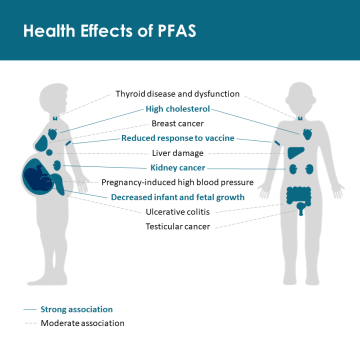Fish Advisories
Eating fish can be a delicious, low cost, and nutritious meal. Some fish may be harmful because they may contain mercury, PCBs, or PFAS. Eating these fish may be harmful for everyone, but especially for:
- Children under 15
- Pregnant people (and the babies they carry)
- People who may become pregnant
- People who are breastfeeding
PFAS in fish and effects on your health
PFAS are a large group of human-made chemicals that are common in the environment. High amounts of PFAS can affect health.
Health Effects

PFAS can cause development problems in children. They can also increase your risk of:
- Certain cancers: Breast, kidney, and testicular
- Damage to organs: Thyroid disease and dysfunction, liver damage, and damage to your digestive tract (ulcerative colitis)
- Pregnancy and birth problems: Pregnancy-induced high blood pressure, decreased infant and fetal growth
- Other health complications: High cholesterol, reduced response to vaccines
PFAS in fish
- Panfish (white bass, bluegill, and crappie) in Dane County tend to have the highest PFAS levels.
- PFAS build up in fish, but there is no pattern where it accumulates.
- PFAS can stay in your body for years. The more fish you eat with PFAS, the higher your chances of health effects.
- We don’t know any ways of preparing or cooking fish that reduces your exposure to PFAS.
Learn more about PFAS in Dane County in our video below.
Mercury in fish and effects on your health
Health effects
- Mercury affects the nervous system.
- It can damage a child’s brain as it develops.
- It can affect children’s behavior and ability to learn.
- In adults, mercury can affect coordination, vision, hearing, and speech.
- It may increase rates of heart disease in men.
All fish contain some mercury. It accumulates in all parts of the fish, including the part you eat.
You can get rid of mercury in your body over several weeks. Spacing your meals out over time helps reduce the amount of mercury in your body.
PCBs in fish and effects on your health
Health effects
- Pregnant people who eat a lot of fish with PCBs may have babies with lower birth weight. Their babies may have physical and learning development delays.
- PCBs can affect your ability to reproduce, affect your immune system, and may cause cancer.
Smaller and younger fish generally have less PCBs. They accumulate in the fat. Carp and catfish, which are fatty fish, may have higher PCB levels.
You can reduce the amount of PCBs in fish by:
- Skinning the fish
- Trimming off fatty parts
- Cooking it to allow fat to drip away (like grilling or broiling)
PCBs get stored in your body fat for many years. Every time you eat fish with PCBs the total amount in your body increases.
Follow Safe Fish Eating Guidelines
Follow these guidelines to reduce your exposure to mercury, PCBs, and PFAS in fish. These guidelines do not apply to restaurant or store-bought fish.
Most Wisconsin inland waters
| Fish Advisory | For children under 15, women of childbearing age | For men, women beyond childbearing age |
|---|---|---|
| Can eat any amount | Bluegill, Crappie, Yellow Perch, Sunfish, Bullhead, Inland Trout | |
| Can eat 1 meal a week | Bluegill, Crappie, Yellow Perch, Sunfish, Bullhead, Inland trout | Walleye, Pike, Bass, Catfish, all other species |
| Can eat 1 meal a month | Walleye, Pike, Bass, Catfish, all other species | Musky |
| Do not eat | Musky |
PCBs
| Fish Advisory | For everyone |
|---|---|
| Badfish Creek & Oregon Branch downstream of Schneider Road | Carp - up to 1 meal a month All other species - see table above |
| Lake Wingra | Carp - up to 1 meal a month All other species - see table above |
| Lake Monona | Carp - up to 1 meal a month, all sizes |
PFAS
Parts of the Yahara Chain of lakes, including Wingra Creek, Lake Monona, Starkweather Creek, Lake Waubesa, Upper and Lower Mud Lake, Lake Kegonsa, and the Yahara River downstream to the Rock River
| Fish advisory for everyone | Up to 1 meal per week | Up to 1 meal per month |
|---|---|---|
| Bluegill | All sizes | |
| Crappie | All sizes | |
| Largemouth bass | All sizes | |
| Northern pike | All sizes | |
| Pumpkinseed | All sizes | |
| Walleye | All sizes | |
| Yellow perch | All sizes |


